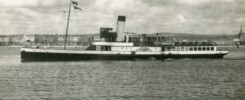
Lord Elgin made her last crossing on the cargo service between Southampton and Cowes on Wednesday 11th May 1955 and moved under her own steam to the scapyard of Pollock, Brown & Co on Friday 13th.
Built for Galloway, Kidd and Watson of Leith in 1876 for their services on the Firth of Forth, she moved to the South Coast in 1881 having been acquired by the newly formed Bournemouth, Swanage and Poole Steam Packet Company for their trips from the rebuilt Bournemouth Pier. There she ran in competition with the expanding fleet of Cosens although arrangements between the two became appear to have become harmonious with a joint Swanage service having been advertised from 1899. She was bought by what became Red Funnel in 1909 and two years later they converted her to carry cargo between Southampton and Cowes. On this service she remained for the next forty four years.

E P Leigh Bennet described her in rather whimsical tones in the 1939 edition of Red Funnel Stuff:
She works Cowes daily throughout the year, just 50 tons at a time, so you see there is no swank about her, merely a forthright paddle promptness weather and other circumstances permitting in the collection and delivery of Island necessities, and the delivery of weekly supplies to the Calshot Spit LIghtship.
Her skipper is a versatile, razor keen individual, who is as unmoved by the presence of 75 head of goggle-eyed cattle on her fore deck on a market day as he is by the presence of 600 ewes (local pronunciation “yoze” please) aft. In fact he is surprised at nothing the Island public needs. This is a quiet morning on the quay, the shimmering stillness of an August heat wave, broken only by the staccato chant of the checker in a railway goods wagon who calls the names of senders and consignees in a flat monotone unrelieved by enthusiasm or blame.
The bright little Island is seemingly insatiable in its needs, and flexible in its habits and palates. For here we have on the after deck a much travelled officer’s valise bespattered with old cloak room tickets, some of Mr Heinz’s 57 varieties, a balloon-tyre red pram, a drum of wire cable from Musselborough, a discreet case of ladies’ underwear marked “assorted”, four gas stoves, one safe for the Head Postmaster at Cowes marked “urgent”, four drums of fish oil for Shanklin’s fish and chip suppers, a barrel of dope for aeroplane wings, a teak garden seat, a little iron cistern for domestic spheres, a parcel of Mr Rowntree’s chocolates, a diving board, a portable bungalow, four sides of prime Danish bacon, a crate of chemist’s sundries – and the checkers chant still going strong.
She suffers stoically an acrid chorus of invective from impatient Island consignees during phases of winter fog which are no fault of hers, and occasionally homing liners suffering from nerves near the shallows of the Brambles make rude and unnecessary funnel noises at her proximity. But she trundles on calmly and through all weather, and is rather an old pet, say what you will. I am drawn to her because she gets all the kicks and none of the excursion fares, and in spite of having the rather raddled look of a woman with a past, she at least earns her keep and a bit more, and carries a blithe ship’s company who would change places with no crew afloat.
In those days, and right on up to the late 1970s, there was no requirement for the master and other officers of home trade cargo ships to hold any certificate of competency issued by the Board of Trade. It was up to the owners and their insurers to appoint crew they judged to be competent and who they judged to be able to successfully run their ships safely in any particular trade. When certification eventually became a requirement those who had been sailing as uncertificated masters and mates were issued with Certificates of Service without examination by the Board of Trade to enable them to continue doing the job that they were already successfully doing.
Capt Joe Sewley was made up as master of the cargo carrying Lord Elgin in 1923 and aboard her he remained for the next thirty two years. After she was withdrawn, despite his unique and unrivalled experience on the Cowes service, a place could not be found for him on the passenger ships so he became berthing master at Southampton until he retired.

On Friday 13th May 1955 Lord Elgin, then nearly eighty years young, made her last voyage under steam from the Town Quay at Southampton round the corner to the breakers yard on the Itchen.
On her arrival at Bournemouth in 1881, Lord Elgin had easily outclassed her competitors as an excursion steamer. Within a decade larger, faster and more commodious steamers easily outclassed her and her stately decline from the long distance luxury steamer through to the local Swanage service and then on to the humble cargo ship quietly plodding backwards and forwards from Southampton to Cowes carrying everything from hatpins to circus elephants is a charming tale which might have popped straight out of the pages of the Revd Audry’s Thomas the Tank Engine stories.
Kingswear Castle returned to service in 2023 after the first part of a major rebuild which is designed to set her up for the next 25 years running on the River Dart. The Paddle Steamer Kingswear Castle Trust is now fund raising for the second phase of the rebuild. You can read more about the rebuilds and how you can help if you can here.
John Megoran
This article was first published on 13th May 2021.


